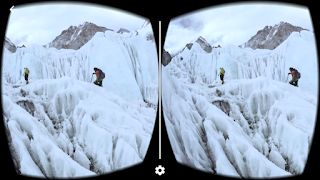Google Cardboard is a cheap, but effective way to view Virtual Reality (VR) content through a smartphone or equivalent device. A while ago I posted about VR and its potential in the classroom (http://blog.mrbwebsite.com/2016/12/2016-was-supposed-to-be-year-of-vr.html). However, my experience with VR has been limited as I did not have the resources to try out the Google Cardboard VR myself.
A little while ago, I received one of these (Google Cardboard) in the mail. I have to admit, it sat on the shelf for a while before I tried it out. Through a chance encounter with one of my fellow staff members, I was introduced to a feature through Time/Life. If you scan certain parts of a magazine, it presents you with a VR experience. So I opened my Google Cardboard, inserted my iPhone 6 and started the app.
The first VR experience was titled Capturing Everest. In this story, the user rides along the back of a Mountain Climber until they reach the summit of Mt. Everest. I must say, I was engaged from the opening scene. I found the depth of field to be stunning. Seeing the summit of Mt. Everest was awe-inspiring, although I am sure, it does not live up to the actual experience. The only downside I saw was that the text can be hard to read due to the zoomed-in resolution of the screen. Sometimes, I would hear someone talking, but not realize I needed to turn around to see them.
I have tried a couple of other apps, but not enough to list recommendations here. Below is an article of suggestions for Google Cardboard VR apps.



Comments
Post a Comment